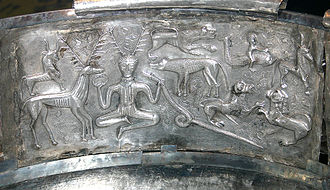Cernunnos

Cernunnos is probably the Latinized name of a Celtic god . His name is interpreted as "the horned one", and he is mostly interpreted from the images as the god of nature, animals or fertility .
Origin of name
The name Cernunnos is mostly "with the corners of the" interpreted as "the horned" or and has been found in this form in Gaul only twice, with a mold (on the Nautenpfeiler ) only fragmentary "[C] ERNVNNOS" shows. Further spellings are Karnonos , Cernenus , Cornutus , Karnuntinus and Kornunus , of which at least three appear as epithets for the Gallic Jupiter, and a Cerunincos is mentioned on a Luxembourg inscription.

distribution
There are no ancient literary mentions of a god Cernunnos, but figurative representations of the "deer antler god" have been found in Gaul , but also in parts of Spain and northern Italy . Overall, traces can be traced from Britain to Gaul, Spain and Italy to Romania . The name of the god only became known recently with the discovery of an inscribed representation on the Pilier des Nautes in Paris . In the so-called Gauls digression of his work De bello Gallico , Caesar reports that the Gauls traced their descent to a night god, whom he equates in Interpretatio Romana with the old Italian Dis Pater . This is the reason why the Celts did not calculate in days but in nights (compare the English word fortnight for a period of fourteen days). Some modern researchers want to recognize Cernunnos in this deity, whose Gallic name Caesar does not mention. Another assumption is that he was the tribal god of the Carnutes , in whose area the central sanctuary of the Druids of Gaul was.

Influences
Iconography of the antler god
In archeology, a male figure with deer antlers is named as the “deer god” or “antler god”, who was often depicted in a seated position, sometimes reminding of the lotus position or a meditating Buddha . The antler god is often depicted as a bearded man, sometimes as a youth, but mostly as a mature man. Further attributes are a cornucopia or a torc and one or more snakes (often the so-called "ram's horn snake"). The best-known depiction associated with the antler god is the relief on the Gundestrup cauldron found in Denmark in 1891 , the origin of which is sought in the eastern settlement area of the Celts (however, the image is interpreted as a shaman with just as good arguments ). The oldest known image to date that could possibly represent Cernunnos is a rock drawing from Val Camonica in the province of Brescia , which shows a mythical figure with raised arms and torques, while a horned snake rises from the ground in front of her. Overall, she looks almost four times larger than the human figures standing around her, who also have raised their arms.
On a bas-relief found in 1710 under the choir of the Notre-Dame de Paris cathedral, the (incompletely preserved) name "[C] ERNVNNOS" is assigned to the depicted god of antlers. The associated monument, the Pilier des Nautes ( cult pillar of the Nautae Parisiaci ), a five-story ashlar column belonging to the guild of river boatmen from the Parisian tribe , originally stood in a central temple in Lutetia , now Paris , and is now in the Musée de Cluny . In addition to the name of the Greco-Roman gods Jupiter , "Volcanus" and the Dioscuri and pictorial representations of Mars and Mercury (perhaps the Fortuna , Juno , Venus and Rosmerta ), the Celtic gods here tarvos trigaranus , Esus , Cernunnos and Smertrios with to see their pictures. In general, animals often seem to have been assigned to the antler god, which is why he is also classified in the context of the representation and worship of a "lord of the animals" .
See also
- List of Celtic gods and legendary figures
- Celtic religion
- Celtic mythology
- Celtic settlement on the Biberg
- List of deities in the Asterix comics
literature
- Michael Altjohann: Cernunnos representations in the Gallic and Germanic provinces. In: Peter Noelke (ed.): Romanization and resistance in plastic, architecture and inscriptions of the provinces of the Roman Empire. New finds and research. Philipp von Zabern, Mainz 2003, ISBN 3-8053-3089-8 , pp. 67-80.
- Bernhard Maier : Lexicon of Celtic Religion and Culture (= Kröner's pocket edition . Volume 466). Kröner, Stuttgart 1994, ISBN 3-520-46601-5 .
Web links
Individual evidence
- ↑ CIL 13, 03026 and Michel Lejeune : Recueil des Inscriptions Gauloises (RIG). Vol. I: Textes gallo-grecs. Ed. du Center National de la Recherche Scientifique, Paris 1985, ISBN 2-222-03460-4 . There the inscription G-224.
- ↑ RIG 1 G-224: αλλετ [ει] υος καρνονου αλ [ι] σο [ντ] εας
- ↑ CIL 03, p 0924.01 , Iovi Cerneni from Roșia Montană in Romania
- ↑ AE 1987, 772
- ↑ Caesar: De bello Gallico. Book VI, Chapter 18.
- ↑ Alexander Demandt : The Celts. 6th edition, C. H. Beck, Munich 2006, p. 10.
- ↑ Umberto Sansoni-Silvana Gavaldo: L'arte rupestre del Pià d'Ort: la vicenda di un santuario preistorico alpino. P. 156 and Ausilio Priuli: Piancogno. In: Itinera. April 1999 (Italian) ( Memento of May 6, 2006 in the Internet Archive ).
- ↑ Thomas Rolleston: Druidism. in Van James (Ed.): Spirit and Art. SteinerBooks, Great Barrington (USA) 2001, ISBN 978-1-62151-089-5 . Cape. IV.2.